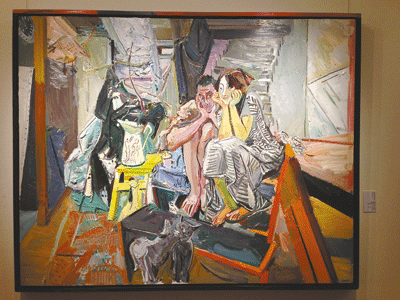Anna Zhao anna.whizh@yahoo.com  MORE than 180 Asian-inspired impressionist oil paintings are on exhibition at the Guan Shanyue Art Museum through Oct. 11. The exhibition, with selected works of 45 contemporary artists, presents for the first time a full scope of the achievements of Chinese artists who are classified as impressionists. Ever since oil painting was introduced to China more than a century ago, Chinese painters have been trying to develop the style with their own characteristics, and there is no lack of attempts among Chinese artists to integrate oil painting with traditional Chinese culture. They have never ceased in their efforts to transcend the barrier between an art expression of Western origin and their Chinese art background. Generally speaking, oil painting artists in China can be categorized into two schools: one school, represented by master painter Xu Beihong, followed the Western tradition of realistic expression; the other school, represented by Lin Fengmian, sought to localize oil painting by integrating traditional Chinese freehand brushwork into oil painting. The latter school, much akin to impressionism in Europe, is known as the Xieyi School — a term usually associated with traditional Chinese painting — because their paintings are identified by imagery commonly seen in traditional Chinese paintings. The concept xieyi, which literally means painting the essence, was attached to oil painting for the first time by artist Fan Di’an. Fan, president of the China Central Academy of Fine Arts, said that the paintings on display embody a common feature: a Chinese base through the use of Chinese brushwork or Chinese aesthetics. The exhibition’s curators said that all of the paintings carry a visual connotation through half-realistic expression. Many of the pieces on display portray subjects with a unique balance of Chinese and Western art styles and techniques. For example, artist Hong Lin’s paintings of snowy scenes have retained the beauty of a water and ink painting; artist Cui Guoqiang used elaborate lines common to fine brushwork painting in his configuration of architecture and trees; a painting by artist Duan Zhengqu presents an overall feeling of Western painting even though he painted in a Chinese style. Wen Zhenfei, art director of the Guan Shanyue Art Museum, said that xieyi paintings are generally created in a casual and smooth style that brings relaxed feelings to viewers, so ordinary viewers with no art background have no difficulty appreciating the art. “While some people have issues understanding avant-garde contemporary art, there are no such problems with xieyi oil paintings because the pursuit of xieyi is in line with popular modern aesthetics,” Wen said. He added that the meanings implied through the lines and strokes in the paintings can be easily recognized. The paintings will tour around the country and be featured in art museums in Xi’an, Zhengzhou, Wuhan, Xiamen and Qingdao. | 
